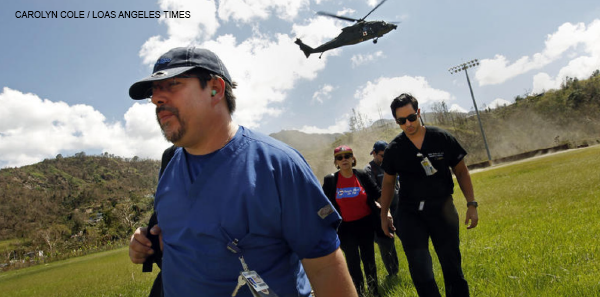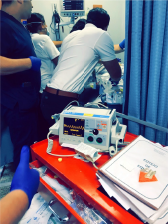
There I was, landing in a town cut off from the outside world by Mother Nature. The distinct sound of the Black Hawk’s four rotors broke through the thin air while horses ran freely and stunned children watched, amazed by the sight of a 12,000-pound machine slowly hovering and touching down on a wet field. For their mothers and fathers, this was a glimmer of hope. Despite all this, it was difficult to ignore the degree of destruction that surrounded us.
Explore This Issue
ACEP Now: Vol 37 – No 02 – February 2018How My Journey Began

Dr. Trivino assisting in the resuscitation of a patient in cardiac arrest.
PHOTOS: Julian Trivino
On Sept. 21, 2017, I was sitting in conference at Florida Hospital when I got a text from one of my attendings: “Would you be interested in going to Puerto Rico [PR] next week?” The worst natural disaster on record had just struck the island of PR, and there were people in need of immediate medical attention. “YES!” I replied. I wanted to be on that island at all costs.
Many of my attendings at Florida Hospital had trained in PR, and although they had lived in the continental United States for many years, their hearts still remained on the island. Following Hurricane Maria, it was evident to them that there were discrepancies between the reports from the media and from physicians whom they had trained with on the ground. While the media reported improvements following the aftermath, the limited communication received by our team portrayed a picture of an island with incredible need for medical relief, supplies, and support. Due to power outages on more than 95 percent of the island, there was limited communication between hospitals, physicians, citizens, and the outside world, leaving the overall health of the Puerto Rican people in question.
As I boarded that flight, I left behind the mainland and any doubt regarding the reason I had chosen this specialty. I was born to do this. My heart filled with joy; my body, with excitement. As my colleagues—Katia Lugo, MD; Alfredo Tirado, MD, FAAEM; and Jorge Lopez, MD, FACEP, from the Florida Hospital emergency department and my fellow resident William Kotler, MD—and I arrived in PR with a plane full of supplies, we began to appreciate the challenges the island faced. From the plane looking down, a stream of lights stretching approximately two to three miles shone brightly, surrounded by darkness—a line of cars waiting to fill up with gas. Some cars had been there for more than 48 hours. The streets were otherwise empty due to a 7 p.m. curfew. Tons of rental cars were available due to the mass exodus from the island, but there was no gas. We caught a ride from an airport employee to our hotel, having to leave all of our supplies behind for the time being. At the hotel, we were met by locked doors and security, as the concern for looting became more prevalent with each passing day. In the hotel, we were greeted by staff ecstatic to see US physicians arriving.
Pages: 1 2 3 | Single Page



No Responses to “An Emergency Medicine Resident’s Journey Through the Devastation of Hurricane Maria”